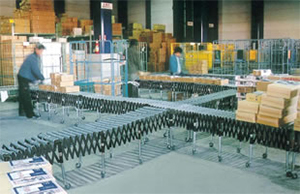Introduction
Conveyor belts are essential components in various industrial applications, facilitating the smooth and efficient transportation of materials across production lines and warehouses. While straight conveyor belts are commonly used, many industries require conveyor systems that can navigate curves to optimize space and improve workflow. This is where curved conveyor belts come into play.
Curved conveyor belts allow for seamless directional changes without interrupting the flow of materials. These specialized belts are widely utilized in industries such as manufacturing, logistics, food processing, and airports to streamline operations and enhance efficiency.

What Are Curved Conveyor Belts?
Curved conveyor belts are belt-driven systems designed to transport materials along a curved path, typically at angles such as 90 degrees or 180 degrees. Unlike straight conveyor belts, which move items in a linear direction, curved belts are engineered to maintain product orientation and positioning as they navigate turns.
Types of Curved Conveyor Belts:
- 90-Degree Curved Belts: These are ideal for tight spaces and sharp turns.
- 180-Degree Curved Belts: Used for U-turns in confined areas.
- Custom Angle Curved Belts: Designed for specialized applications requiring unique angles.
Materials used in curved conveyor belts vary based on application requirements. Common materials include:
- Rubber: Provides durability and flexibility.
- PVC (Polyvinyl Chloride): Resistant to chemicals and moisture.
- PU (Polyurethane): Ideal for food-grade applications due to its hygienic properties.
- Metal Mesh: Used in high-temperature environments such as baking and metal processing industries.

How Do Curved Conveyor Belts Work?
Curved conveyor belts operate using specialized components that enable smooth and controlled movement through turns. Their design ensures minimal friction, stable product handling, and continuous material flow.
Key Components:
- Rollers and Bearings: These help reduce friction and guide the belt along the curved path.
- Guiding Systems: Ensures that products remain aligned while moving through the curve.
- Belt Tensioning System: Maintains the proper tension to prevent slippage and misalignment.
- Motorized Drive Systems: Provide the necessary force to move the belt smoothly, even around bends.
By integrating these components, curved conveyor belts ensure efficient material handling without requiring multiple straight conveyors and transfer points.
Advantages of Curved Conveyor Belts
- Space Optimization: Reduces the need for extra conveyor systems, making better use of available space.
- Improved Efficiency: Enables continuous product movement, minimizing delays.
- Reduced Manual Handling: Decreases labor requirements and enhances workplace safety.
- Fewer Transfer Points: Minimizes the risk of product damage and misalignment.
Applications of Curved Conveyor Belts
Curved conveyor belts are widely used across various industries, including:
- Manufacturing: Enhancing assembly line efficiency by enabling smooth product movement.
- Logistics & Warehousing: Facilitating quick and effective package sorting and handling.
- Food & Beverage: Ensuring safe and hygienic transportation of perishable goods.
- Airports: Streamlining baggage handling systems for faster and more efficient passenger service.
Factors to Consider When Choosing a Curved Conveyor Belt
Selecting the right curved conveyor belt depends on several factors:
- Belt Material: Choose based on durability, resistance to wear, and application requirements.
- Load Capacity & Speed: Ensure the belt can handle the expected weight and operational speed.
- Space & Layout Constraints: Consider the available space and the desired curve angle.
- Maintenance & Costs: Factor in long-term operational costs and ease of maintenance.
Common Challenges and Maintenance Tips
- Belt Misalignment: Regularly check and adjust the belt alignment to prevent disruptions.
- Wear & Tear: Conduct routine inspections and replace worn-out components promptly.
- Safety Considerations: Implement proper safety measures to prevent workplace accidents.
Conclusion
Curved conveyor belts play a crucial role in optimizing industrial material handling processes by efficiently navigating turns and reducing the need for multiple transfer points. Their ability to enhance workflow, save space, and improve efficiency makes them indispensable in industries ranging from manufacturing to logistics.
For expert advice on selecting the best curved conveyor system for your needs, contact Okura today and explore our range of conveyor belt solutions.


